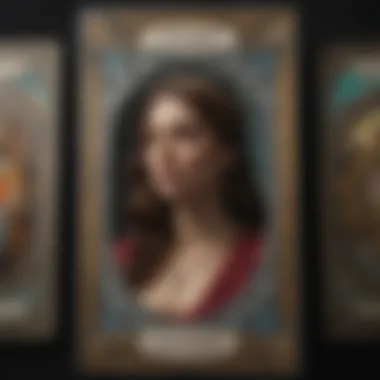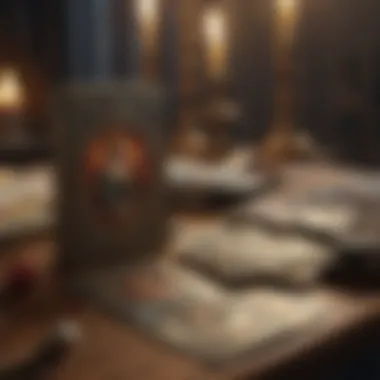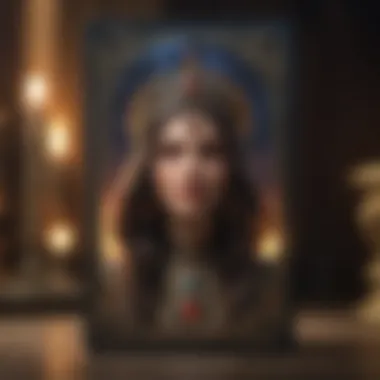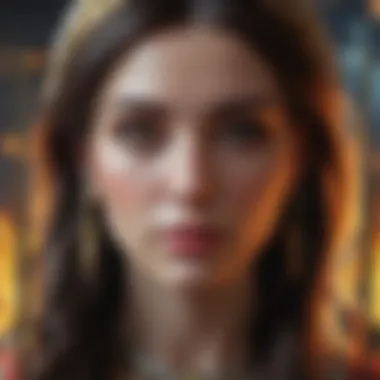Unlocking the Secrets of Every Tarot Card Explained


Intro
Tarot is a fascinating art deeply intertwined with symbolism, intuition, and personal reflection. Each card within the tarot deck holds its own meaning, serving as a window into the psyche of the querent. Understanding the meanings of these tarot cards enhances one's ability to accurately interpret readings and apply insights into daily life.
Tarot readings can provide clarity and guidance, making the understanding of each card critical for anyone seeking to engage with this ancient divination tool. This article will explore the significance of every card, both in its upright and reversed positions, allowing practitioners at any level to develop a richer experience with their readings.
Understanding the Zodiac
Overview of Zodiac Signs
Zodiac signs, often associated with astrology, correspond to constellations in the celestial sphere. Each of the twelve zodiac signs possesses unique traits and resonates with specific elements. While the connection between astrology and tarot may not be immediately apparent, awareness of zodiac influences can deepen the interpretation of tarot readings.
Sign Traits and Characteristics
Each zodiac sign carries distinct traits:
- Aries: Impulsive, courageous, and energetic.
- Taurus: Practical, determined, and sensual.
- Gemini: Adaptable, communicative, and curious.
- Cancer: Emotional, nurturing, and protective.
- Leo: Confident, creative, and charismatic.
- Virgo: Analytical, meticulous, and service-oriented.
- Libra: Diplomatic, charming, and fair-minded.
- Scorpio: Intense, passionate, and transformative.
- Sagittarius: Adventurous, optimistic, and freedom-loving.
- Capricorn: Disciplined, ambitious, and prudent.
- Aquarius: Innovative, humanitarian, and unconventional.
- Pisces: Compassionate, artistic, and mystical.
Elemental Qualities
Zodiac signs are divided into four elemental categories, which influence their characteristics:
- Fire Signs (Aries, Leo, Sagittarius) - Energetic and passionate.
- Earth Signs (Taurus, Virgo, Capricorn) - Grounded and practical.
- Air Signs (Gemini, Libra, Aquarius) - Intellectual and social.
- Water Signs (Cancer, Scorpio, Pisces) - Emotional and intuitive.
These elemental qualities uniquely embody the essence of each sign, and understanding them can inform how tarot cards reflect or counteract these traits.
Astrological Insights
Current Astrological Trends
The tarot reader's understanding of current astrological transits can heighten the quality of a reading. Whether a planet is in retrograde or passing through specific houses, these movements affect the energy surrounding both querent and tarot cards.
Influence of Celestial Events
Significant celestial events, like eclipses or planetary alignments, can transform the meaning of tarot cards during a reading. For example, a reading performed during a full moon may emphasize completion and revelation.
How to Interpret Your Birth Chart
A birth chart contains the positions of celestial bodies at the exact moment of birth. From it, one can understand underlying motivations and personality traits, which may explain specific card draws during a tarot reading.
Horoscope and Predictions
Monthly or Weekly Forecasts
Tarot readings can serve as forecasts, offering insights that sync with current astrological energies. Monthly or weekly forecasts can be guided by the dominant themes of the tarot cards drawn.
Personalized Horoscope Reading
A personalized horoscope using both zodiac signs and tarot cards can yield deeper insights into life events or decisions facing the querent.
Compatibility Readings based on Zodiac signs
Analyzing compatibility through zodiac signs allows for a more nuanced approach in tarot readings focused on relationships. Specific cards may resonate differently based on the zodiac influences of the individuals involved.
Preface to Tarot
In the realm of divination, Tarot serves as a vital tool for introspection and guidance. Understanding Tarot begins with recognizing its historical significance and the layers of meaning embedded within each card. This article aims to unravel these layers, providing clarity for both newcomers and seasoned practitioners.
History and Origins of Tarot


The origins of Tarot are somewhat obscure, dating back to the 15th century in Europe. Initially, Tarot cards served as a playing card deck rather than a divination tool. Over time, their use evolved alongside mysticism and occult practices. Early tarot decks, such as the Visconti-Sforza, showcased artistic depictions reflecting the cultural themes of their times.
There are theories that connect Tarot to ancient Egyptian and Kabbalistic traditions, lending depth to its symbolic meanings. Despite the variations in interpretation, one theme remains constant: Tarot serves as a mirror, reflecting the complexities of human experience.
Structure of the Tarot Deck
Major Arcana
The Major Arcana consists of 22 cards, symbolizing significant life events and spiritual lessons. Cards like The Fool, The Magician, and The High Priestess tackle deep existential themes. Each card stands as a symbolic archetype that resonates across cultures and epochs. This significant aspect makes Major Arcana a core focus in any Tarot reading. It is well-regarded for its representation of profound life choices.
One unique feature of the Major Arcana is its sequential order that impacts the narrative flow within a reading. The journey from The Fool to The World encapsulates a full cycle of growth, maturity, and knowledge. This characteristic makes it a beneficial choice for those seeking comprehensive insights into their lives.
Minor Arcana
In contrast, the Minor Arcana consists of 56 cards divided into four suits: Cups, Swords, Wands, and Pentacles. Each suit addresses everyday situations and issues, allowing for more nuanced interpretations that relate to day-to-day experiences.
The key highlight of the Minor Arcana is its accessibility. It enables users to draw connections between broader themes presented in the Major Arcana and the specifics of their life circumstances. Each card offers contextual meaning that helps to decipher immediate concerns or challenges.
The unique features of the Minor Arcana include the depth it adds to readings. It narrates stories that are often overlooked when one focuses solely on the Major Arcana. This aspect can both enhance and complicate readings, depending on the reader's skill level and familiarity with the suits.
Purpose of Tarot Readings
Tarot readings serve multiple purposes, from self-reflection to decision-making. They provide insight into past influences, current situations, and potential future outcomes. Through this lens, practitioners can gain clarity, strategize, and foster personal growth in various aspects of life. This functionality positions Tarot as more than a mere divination tool; it is a resource for practical wisdom and empowerment.
The Major Arcana
The Major Arcana forms the heart of the Tarot deck, comprising 22 cards that represent significant life experiences and deep spiritual lessons. Each card in this section serves as a powerful archetype, offering profound insights into the human condition. Understanding these cards enables a deeper connection to the nuances of Tarot readings, as they often reflect core themes that transcend the mundane.
The prominence of the Major Arcana in a reading sheds light on fundamental life questions or situations. When they appear, they signal important moments or turning points in a person's journey, urging one to introspect and consider their path. Therefore, knowing the meanings and implications of these cards is essential for anyone looking to harness the Tarot for guidance, personal growth, or divination.
The Fool
The Fool is often seen as the starting point of the journey through the Major Arcana. Symbolizing new beginnings and potential, this card depicts a figure poised at the edge of a cliff, representing the leap into the unknown. The Fool encourages openness and spontaneity, advocating for a carefree approach to life. It invites the querent to embrace their intuition and take chances. With its inherent message of renewal, it reminds us that every journey starts with a single step.
The Magician
The Magician embodies resourcefulness and manifestation. This card suggests that one has all the tools necessary to achieve their goals. The Magician's presence encourages proactive behavior and confidence in one's abilities. It is often associated with creativity and skill, offering the signal that the querent can control their fate through determined action. This card emphasizes the connection between intention and outcome, reminding us that our thoughts shape reality.
The High Priestess
The High Priestess represents intuition and hidden knowledge. She is often depicted with a book or scroll, symbolizing wisdom and the unconscious mind. This card encourages the querent to trust their intuition and seek answers from within. In readings, it may indicate the need for patience and contemplation, suggesting that not all truths are apparent on the surface. The High Priestess invites exploration of the mystical and unknown, which can lead to profound insights.
The Empress
The Empress is a symbol of fertility, abundance, and nurturing energy. This card often reflects themes of motherhood and creativity. It emphasizes the importance of connection to nature and the nurturing aspects of life. In a reading, her presence may signal a time of growth, whether in personal endeavors or creative projects. The Empress encourages the querent to embrace their sensuality and recognize the beauty around them, reinforcing the significance of self-care and emotional well-being.
The Emperor
The Emperor stands for structure, authority, and leadership. He represents the principle of governance and order, suggesting the querent may need to take control of a situation or establish boundaries. This card often highlights the importance of discipline and responsibility. In readings, The Emperor may indicate a need for stability or the application of logic and reason in decision-making. His presence can promote confidence in one’s abilities to lead and organize.
Additional Major Arcana Cards
The Lovers
The Lovers card expresses themes of choice, harmony, and relationships. It signifies a powerful connection between individuals, whether in romantic partnerships or deep friendships. This card encourages introspection about one’s values and desires, advocating for authentic communication and mutual respect. It prompts the querent to weigh decisions and consider how relationships influence their life journey. The Lovers also highlight the importance of balance and unity in any relationship, making it a popular choice in interpretations concerning partnerships.
The Chariot
The Chariot symbolizes victory, willpower, and determination. It suggests that success is achievable through focused effort and control over one's emotions. This card encourages the querent to embrace challenges with confidence and determination. In readings, The Chariot often indicates travel or movement, both physically and metaphorically. Its presence reinforces the power of perseverance and suggests staying the course despite obstacles.
Justice


Justice is linked to fairness, truth, and moral integrity. This card prompts the querent to assess their actions and the consequences that arise from them. It may appear when important decisions regarding ethics or accountability are at hand. Justice encourages individuals to examine their values and assures that fairness will prevail in the end. It signifies balance and the pursuit of truth, positioning it as a vital card in discussions of decisions and their implications.
The Hermit
The Hermit embodies introspection, solitude, and inner guidance. This card urges the querent to step back and examine their life from a different perspective. The Hermit highlights the importance of self-reflection and personal understanding. It can indicate a time of withdrawal necessary for personal growth. In readings, this card often suggests seeking counsel from within, advocating for a pause to gather wisdom and insight before moving forward.
Understanding Reversed Major Arcana
When the Major Arcana cards appear in reversed positions, their meanings shift, often reflecting internal conflicts, delays, or challenges. Reversed cards may indicate a blockage in the energies represented by the card or offer warnings about the potential consequences of inaction or miscommunication. Understanding these reversed implications is crucial for a holistic reading. This requires not just knowledge of the upright meanings but also an awareness of how circumstances can alter their significance.
The Minor Arcana
The Minor Arcana comprises a vital part of the Tarot deck, providing depth and context to tarot readings. While the Major Arcana represents significant life events and deep archetypal energies, the Minor Arcana focuses on the day-to-day experiences that shape our lives. It consists of four suits: Cups, Swords, Wands, and Pentacles. Each suit has its unique emphasis, allowing readers to gain insights into different aspects of life such as emotions, thoughts, actions, and material concerns.
Understanding the Minor Arcana enhances the overall meaning of a tarot reading. The cards in this section often reflect current situations or feelings and can provide guidance in navigating personal challenges. Additionally, the Minor Arcana's detailed nature gives a more nuanced interpretation of a person's circumstances, heightening the effectiveness of tarot as a tool for self-discovery.
Cups Suit
Meaning of Each Card in the Cups Suit
The Cups suit embodies the realm of emotions, relationships, and connections. Each card in this suit has its symbolic meanings, portraying various emotional states and experiences. For instance, the Ace of Cups often indicates new beginnings in love or emotional well-being, while the Three of Cups represents celebration and friendship.
A key characteristic of the Cups Suit is its focus on interpersonal dynamics. Readers find it particularly beneficial because it addresses issues of emotional depth and intuition. The suite encourages introspection and reflection, essential aspects of gaining insight into personal relationships.
However, the unique feature of this suit can also present certain challenges. Emotional cards can sometimes lead to ambiguity in readings, making it necessary for readers to be grounded and clear in their interpretation.
Reversed Interpretations for the Cups Suit
Reversed interpretations of the Cups suit offer another layer of meaning. When these cards appear upside down, they indicate blockages in emotions or difficulties in relationships. For example, the reversed Two of Cups often signifies broken connections or discord.
The key characteristic of reversed Cups cards is the emphasis on introspection and the need to address unresolved feelings. This feature can be beneficial as it prompts individuals to confront issues that might otherwise remain buried. However, the downside is that these interpretations might evoke discomfort, as they call for self-assessment.
Swords Suit
Meaning of Each Card in the Swords Suit
The Swords suit represents thoughts, intellectual processes, and conflict. The cards symbolize mental clarity, truth, and the often challenging path of making decisions. For instance, the Ace of Swords is seen as a card of breakthroughs and new ideas, while the Ten of Swords often signifies betrayal or painful endings.
A key aspect of the Swords suit is its direct confrontation of issues. This makes the suit a popular choice for those seeking clarity in complex situations. Its focus on the mind rather than heart makes it essential for understanding challenges logically.
The unique feature of the Swords suit is its duality, revealing not only the need for clear thought but also the potential for isolation and conflict. Thus, it is essential to approach readings with care to avoid overwhelming interpretations.
Reversed Interpretations for the Swords Suit
Reversed cards in the Swords suit can indicate confusion or deception. The reversed Five of Swords may imply a need to reconsider a conflict or a warning against excessive competition.
The characteristic of reversed Swords cards is their ability to shed light on issues that require resolution. They prompt discussions about self-deception or dishonesty, making them a valuable tool for personal growth. However, they may also create tension when pointed truths are uncovered, creating discomfort in readings.
Wands Suit
Meaning of Each Card in the Wands Suit
The Wands suit is associated with creativity, action, and initiative. This suit embodies inspiration and the drive to pursue goals. For instance, the Ace of Wands signifies new ideas, and the Six of Wands represents victory and recognition.
A key characteristic of the Wands suit is its dynamic energy and focus on ambition. It empowers individuals to take action and pursue what they genuinely desire. This proactive approach can be very beneficial for readers seeking to ignite passion in their lives.
However, the unique feature of the Wands cards can also lead to impulsiveness. It is crucial for readers to balance the enthusiasm of this suit with thoughtful consideration of the consequences of their actions.
Reversed Interpretations for the Wands Suit
Reversed interpretations of the Wands suit point to obstacles and delays. The reversed Seven of Wands indicates struggles to maintain one's position or confidence.


A key aspect of these reversed cards is their potential to reveal unrecognized challenges. They prompt a reflection on one's goals and the necessary adjustments to achieve them. Nonetheless, their implications can sometimes bring frustration, as they highlight a divergence from the desired path.
Pentacles Suit
Meaning of Each Card in the Pentacles Suit
The Pentacles suit is linked to material aspects and the physical world. It deals with finances, career, and resource management. For example, the Ace of Pentacles indicates new financial opportunities, while the Five of Pentacles signifies financial loss or hardship.
A key characteristic of the Pentacles suit is its grounded nature. Readers often find this suit beneficial when focusing on tangible outcomes and practical matters in life. Its association with stability provides a solid framework for readings.
Yet, the suit can also reinforce material concerns that may lead to stress or anxiety. Interpreting these cards requires a delicate balance to avoid becoming too focused on materialism.
Reversed Interpretations for the Pentacles Suit
Reversed Pentacles cards often highlight instability or financial mismanagement. The reversed Four of Pentacles might suggest a need to let go of control.
The unique feature of these interpretations is their ability to address financial pitfalls or mindset changes necessary for success. They encourage readers to evaluate their relationship with resources. However, this focus could also prompt anxiety, especially if the querent is facing significant financial challenges.
The Minor Arcana provides a comprehensive perspective on the nuances of everyday life within tarot readings, making it essential for insightful interpretations.
Applying Tarot Card Meanings
Understanding how to apply tarot card meanings is crucial for anyone seeking to deepen their practice. Tarot is not just about deciphering individual cards; it is about how these cards interact within a reading to provide insight. When interpreting a spread, one must consider the relationship between the cards, their positions, and the questions posed. This multifaceted approach allows for a more nuanced understanding of situations and potential outcomes.
Common Spreads and Layouts
Different tarot spreads serve various purposes and help focus the reading. Common spreads include the three-card spread, the Celtic Cross, and the one-card draw. Each layout offers its distinct insights and benefits. For example, the three-card spread can be used for insights into the past, present, and future. In contrast, the Celtic Cross provides a broader view of a person’s situation, evaluating challenges, influences, and potential outcomes.
Utilizing different layouts encourages flexibility in interpretation. Readers may find that one layout fits a particular inquiry better than another. Always consider the context of the question and the nature of the query when choosing a spread.
Key Spreads:
- Three-Card Spread: This offers a quick look at past, present, and future.
- Celtic Cross: This layout provides an in-depth exploration of a situation.
- One-Card Draw: Perfect for daily guidance or focused questions.
Interpreting Card Combinations
The interactions between tarot cards play a significant role in their meanings. When multiple cards appear in a reading, their meanings can shift depending on their positions relative to each other. For instance, if the Death card is drawn alongside the Two of Cups, this may imply a transformative phase in a relationship. Alternatively, the same Death card combined with the Eight of Swords might indicate feeling trapped by change.
Understanding these combinations requires one to be familiar with each card's meanings as well as how they might amplify or negate each other's impact. The context of the reading is also vital; the same cards could signal different things based on the querent's specific situation or question.
Practical Applications of Tarot Insights
Tarot insights can be remarkably practical in daily life. They can help individuals navigate personal challenges, relationships, and career decisions. Utilizing insights from a reading can aid in fostering self-reflection, promoting awareness of unconscious patterns, and informing actionable steps.
For example, if a reading reveals a lot of cards from the Swords suit, it may indicate the need to address mental challenges. The querent might then choose to engage in mindfulness practices or seek solutions to ease their mental burden.
In incorporating tarot readings into life, it may be useful to keep a journal to track the outcomes of readings and the paths taken afterwards. This can deepens the understanding of tarot's relevance and support personal growth over time.
Effective application of tarot card meanings often leads to transformative experiences and greater clarity in decision-making.
The End
Reflecting on Tarot as a Tool for Self-Discovery
Tarot has long been valued not only as a divination tool but also as a means for self-reflection. By engaging with the cards, individuals can uncover layers of their subconscious thoughts and emotions. The process of drawing cards often prompts introspection that leads to personal growth. Through understanding the messages of the cards, practitioners can identify patterns in their behavior, recognize areas in need of change, and embrace new opportunities.
The imagery and symbolism of each card resonate deeply, providing meaningful insights that can be applied in daily life. For instance, drawing The Fool can remind one to embrace spontaneity, while The High Priestess often encourages trust in one’s intuition. This self-discovery process is not merely passive; it becomes an active dialogue between the reader and their inner self.
"Tarot should be viewed not just as a tool for prediction but as a vehicle for growth and understanding.”
Future of Tarot in Modern Practice
Tarot continues to evolve as society changes. The growing interest in spirituality and self-help practices has brought tarot back into mainstream awareness. People are increasingly turning to tarot not only as a form of entertainment but as a serious method for gaining insights into their lives.
The digital age has transformed how tarot is accessed and utilized. Online readings and apps allow for instantaneous connections to tarot, making it more accessible. Communities on platforms like Reddit and Facebook facilitate discussions among enthusiasts and practitioners, fostering a rich environment for learning.
As tarot adapts to modern contexts, it is essential for practitioners to remain informed about both traditional meanings and contemporary interpretations. This balance supports an adaptable practice that resonates with today’s seekers. Embracing the future of tarot ensures its relevance and beneficial impact will endure for generations to come.







